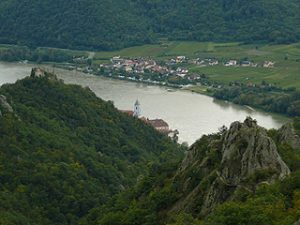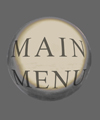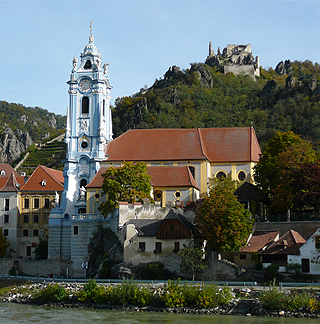The charming village/town of Dürnstein is best approached from Krems, either by river or by walking through the vineyards from Stein. Ferries leave from the World Cultural Centre built in honour of the Wachau, Melk and Krems being recognised as UNESCO world heritage sites. Both the Danube Steamship Company (DDSG) and the local company Brandner operate ferries with the former being accompanied by an inescapable verbal commentary whilst the later is uncommented. See www.ddgs-blue-danube.at & www.brandner.at
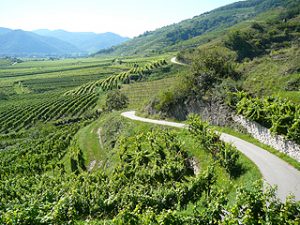
Along the way one passes on the left-hand side, first Lower and then Upper Loiben and as one approaches Dürnstein, a bullet-shaped monument that catches one’s attention. This is the so-called „French Monument“ which despite its name was built to commemorate not only the French but also the Austrian and Russian solders who fought at the Battle of Dürnstein and Loiben. This was fought on 11th November, 1805, on the flood-plain between the River Danube and the hills to the North. Although Napoleon claimed the battle as a victory, the forces of the Third Coalition emerged from the conflict better off than the French. In Museum Krems a painting from the same year shows a scene from the encounter.
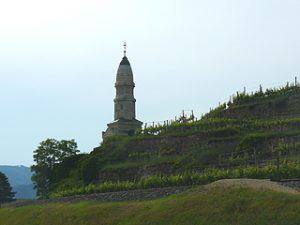
Just outside Dürnstein, the façade of a yellow and white folly catches the eye, rising in a series of Baroque curls from among the enclosing terraces. Along with the modern buildings that adjoin, this is where the Domäne Wachau presses grapes from the surrounding vineyards and ages them in the cellars below. Where the word „Wachau“ is often used to refer to the part of the Danube Valley that extends from Krems to Melk, when it comes to wine-growing, it refers to a much shorter stretch. This latter runs from Loiben to Aggsbach Markt on the northern side and from Mautern to Sankt Johann im Mauerthale on the southern side. The Domäne thus lies at the heart of the wine growing area and is a cooperative that processes the grapes from around 250 families who run small wine-gardens according to agreed and sustainable codes of practice. Producing some two million bottles a year, this accounts for approximately a third of the wine that the Wachau produces and for the collective, the character of the region and its preservation is of central importance.
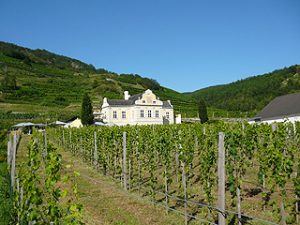
The Baroque folly was built to celebrate „the joys of life“ by the Provost Hieronymus Übelbacher, who from 1710 up until 1740 was abbot of the Augustine Monastery at Dürnstein.
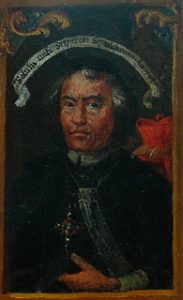
Hieronymus Übelbacher (1674-1740)
Despite having doctorates in both philosophy and theology, Übelbacher lived life to the full and was ever ready to host and indulge in festivities and celebrations. Inside the folly two mottos proclaim: „wine is everything“ and „wine is over and above everything“. Wine being essential to the Christian sacraments, whilst reflecting Übelbacher’s joie de vivre, these mottos also have a pious aspect to them and imply that, well-earned and in their right place, the joys of man can contribute to the joy of God. The joy of God is not only added to through prayer but through people living fulfilled lives, using all of their various faculties and gifts in the ways that God intended. Among Hieronymus Übelbacher’s gifts was a sense for business and below the Baroque folly, a huge stairway leads down into the cellars which were built as a part of an endeavour to professionalise and raise the standards of wine-making at Dürnstein.
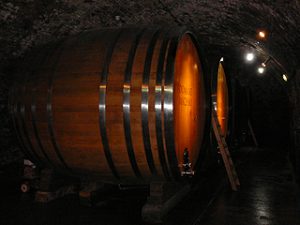
The cellars are fifteen metres below ground and can be visited as part of a guided tour which is given in German and ends with a wine tasting. Learning about the grapes that are used to make the region’s wines and the factors that make the landscape unique, one is better able to appreciate the Steinfeder, Federspiel and Smaragd wines that the winery produces. Apart from its „standard“ wines, the Domäne also bottles wines from specific terroirs enabling one, with reference to two different wines, to taste one’s way along the Wachau. In addition, Kellermeister Heinz Frischengruber is keen on experimenting with an area of the cellar being dedicated to experiments.
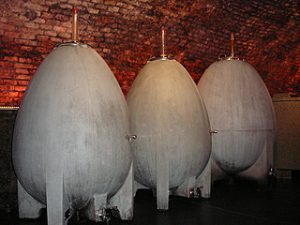
Here, wines are aged in concrete egg-shapes vats, in vats made of local marble and in amphorae. The standard wines, terroir wines and the „backstage“ experiments can all be sampled and purchased at the winery’s vinotheque. In addition, the winery distils some of the Veltliner wine that it produces to make a Weinbrand, which is then aged for twenty-two years, resulting in a brandy that is exceptionally smooth. See www.domaene-wachau.at
For the Romans, although the Danube was used as a waterway, it was first and foremost a defensive barrier that delineated the north-eastern limits of the empire. Thus on the northern slopes of the river, grapes were not grown until the Age of Migration came to an end and monks from Germany began to terrace and plant up the south-facing slopes. As wine plays an essential role in the Christian sacraments, for spiritual reasons wine-making was integral to the running of a monastery. Yet it quickly became an important part of the economic package that made monasteries work financially and soon enough, large quantities of wine were being exported from the Wachau, up-river to Germany.
The monks who founded Dürnstein came from Tegernsee and knew that the warm, northern slopes were ideal for wine-growing. Moulding the landscape into terraces, conditions were created that enabled wines to be produced that during the Middle Ages, were renowned far and wide. The area was evidently „good“ and its colonisation was all part and parcel of the fulfilment of God’s will. In this way, the permanent exhibition The Good-The Beautiful-The True that is on view at the Dürnstein Abbey introduces the theme of „The Good“. The exhibition sees the good as being epitomised by the Christian sacraments and the mystic transformation of bread and wine into the body and blood of Christ. The miracle is then enshrined and enhanced in the monstrance that holds the wafers of bread and by the chalice that contains the wine. These are instances of „The Beautiful“ ̶̶ that which preserves the good and which has the capacity to lead us towards „The True“. Yet as the exhibition shows, a well-managed landscape is also beautiful and is the result of work carried out according to an ethos in which beauty and truth are striven for. In this way the exhibition presents Dürnstein’s own history as a striving towards the good, the beautiful and the true.
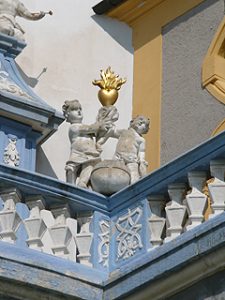
At Dürnstein Abbey, the idea of creating beauty on earth that points up to God was pursued on an ambitious scale by Provost Übelbacher. When first elected provost, the church and monastery were in a poor state of repair and Übelbacher initiated a program in which the medieval buildings were repaired and given Baroque façades. Where the Domäne Wachau folly celebrates the joys of earthly life, the monastery and church are dedicated to the joys and mysteries of eternal life. Every detail is important and the monastery can be seen as a work of art in itself, with its elements all co-ordinated so as to testify to the glory of God and show the meaning and beauty of life on Earth. The church tower is painted blue and white ̶̶ the colours of the sky towards which it reaches up. Meanwhile, inside the art and architecture are masterfully combined to create a synthetic, effusive whole that catches the essence of the Baroque. Often the artistic quality of individual pieces does not match up with the standard that the whole is aiming at but this is not the point for it is the impression of the whole that is of overriding importance.
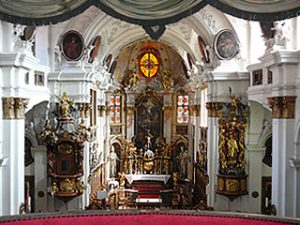
Highly unusual and indicative of Übelbacher’s attention to detail is the rotating tabernacle that is a part of the altar. Spherical and divided into sections like a globe, it is adorned with forty-four scenes from the New Testament. Conceived of by Übelbacher, this spiritual globe-cum-armillary sphere has Christ at its centre and was a collaborative effort that involved three artists. Inside the most sacred of things, the consecrated host was kept until ready to be dispensed to the faithful.
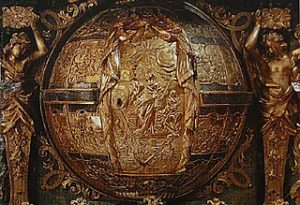
The exhibition thematises the three themes that are essential for any form of genuinely communal life ̶̶ that is a life in which values and ideals are shared and striven for and where there is a clear sense of a „common weal“. First identified by Plato, the good, the beautiful and the true and their interrelated nature are notable today by their absence and the extent to which they are ignored by mainstream culture and politics. In getting to the heart of the matter, the exhibition uses modern didactic strategies and presentation techniques to help the viewer enter into and experience a Baroque view of the world. As for such an ambitious undertaking the exhibition’s written descriptions are decidedly sparse, the renting of an audio guide or the purchasing of the modestly priced exhibition catalogue is to be recommended. For opening times see www.stift-duernstein.at
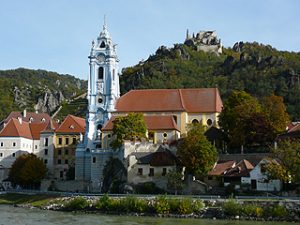
While the setting up of a monastery at Dürnstein brought with it the promise of an increase in prosperity and economic activity in the region, it could not guard against bands of lawless brigands or other forms of aggressive threat. This was provided for by the Kuenringer, Hadmar I, who in the middle of the twelfth century built the castle that overlooks the town. From the castle, walls run down towards the town’s eastern and western gates.
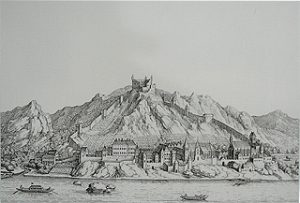
Forty years later it was here that Richard the Lionheart was imprisoned and held to ransom as the unwilling guest of Hadmar II. As leader of the Third Crusade, Richard also saw himself as the executor of a divine plan in which the good, the beautiful and the true were by definition all integrated. The circumstances of Richard’s fourteen month stay lead to the first written mention of Dürnstein and today can be experienced as a Richard the Lionheart trail with informative texts in English and German and period depictions of the main characters mounted on sheets of steel. This starts from the south-eastern corner of the old town, at a point next to the river just outside the city-wall. Then it leads past the eastern gate before beginning the steep ascent up to the castle, with a path of loose stones winding its way among the rocky crags. Printed leaflets are available at the Tourist Information Office near where the S5 Donau Bundestraße emerges from the eastern end of the tunnel that diverts the busy road into the rock and away from the town. Meanwhile online information is available at www.duernstein.at by following the link „The Trail“.
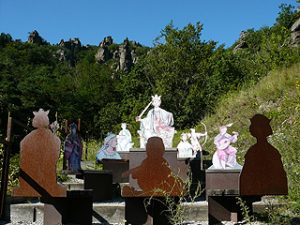
For the adventurous, fifteen minutes beyond the Medieval castle, there is a later defensive structure known as the „Tarbor“. This was more of a heavily defended house than a castle. Documentary evidence for the Tarbor comes in the form of a coat of arms which were granted to the town in 1476 and it is assumed that the structure dates from this time.
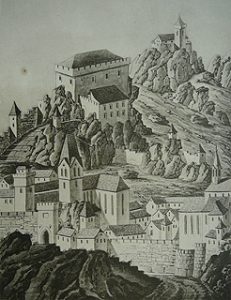
West of the Medieval castle, a path leads North and a long stairway formed by huge slabs of stone winds its way through the woods. Follow this up for fifteen minutes and the at the brow of the hill turn right. Perched on the brow of a hill, the Tarbor is surrounded by spectacular rocky crags, from which the Medieval castle can be looked down upon.
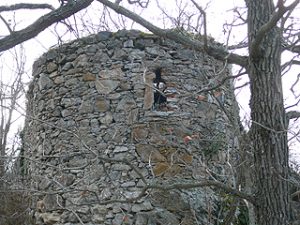
Following the green markings on up through the woods leads to the top of a hill on which there is the Starhemberg Tower which for a voluntary donation, offers panoramic views. A short distance away there is the Fesslhütte which is a café where refreshments may be enjoyed. West of the ridge on which the Tarbor stands and running parallel to it, there is a second ridge. Here, on the East side, there is the Vogelberg Steig, with narrow paths that lead up the steep slope and wire ropes to hold on to where there are cliffs and sheer drops. At the top, the Vogelberg offers spectacular views in all directions. Following the path East through the woods again leads to the Fesslhütte. For a circular route that includes all of the above see: www.bergfex.at.
Less well-known but of major economic significance to the Wachau is the story of another crusader who returned from the Holy Land with a bag of saffron bulbs. With these he was able to woo a noble lady who had promised her hand in marriage to whoever brought her the East’s most precious gift. For three hundred years, significant quantities of saffron were grown in the Wachau and in Krems, a yearly saffron market was held.
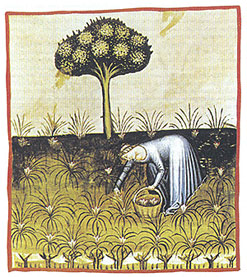
Saffron picking as depicted in the Tacuinum Sanitatis Codex that dates from the fifteenth century
Investigating this story, the ecologist Bernhard Kaar realised that it was for him to revive this lost tradition and bring saffron farming back to the Wachau. The Wachauer Saffron Manufactory is only a few minutes away from the town’s eastern gate. Housed in the old railway station, this is where sight-seeing trains still stop (www.wachaubahn.at) and here a cup of coffee and an Austrian kind of saffron cake may be enjoyed whilst looking up at the ruins of Dürnstein Castle. Meanwhile for those back at home, a range of saffron enhanced products such as chocolate, honey and pasta can be bought as presents. For more information see www.safranmanufaktur.com and the Bernhard Kaar article on the „People“ page of Reloading Humanism.
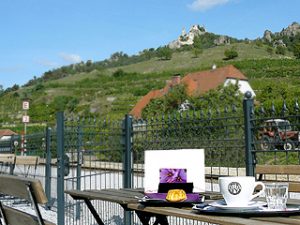
At the eastern end of the town, on the main street at 11a, the Dömane Wachau has a small outlet where for those who missed the „ab hof“ or direct outlet, the cooperative’s products may also be purchased and a glass of wine enjoyed.
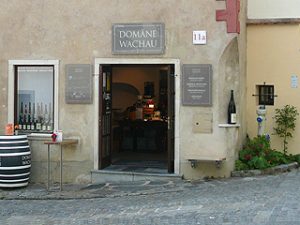
In the heart of Dürnstein, on the main street at number 21, there is the Schmidl Bakery which was founded in 1780 and has been at number 21 since 1857. Here a wide range of bakery products are made from locally produced flour. These include „Wachauer Laberl“, rolls that are stamped on the bottom with a distinctive „S“ and which do not disappoint. See www.schmidl-duernstein.at. Adjoining the bakery is a „Konditorei“ where breakfast, a snack lunch or coffee and patisseries can be enjoyed.
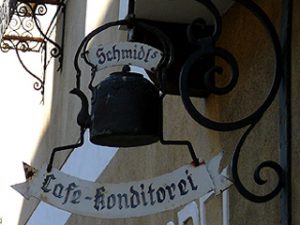
At the western end of Dürnstein, there is the Palace Hotel. Once the residence of the Duke of Starhemberg, it is now an up-market hotel that runs a quality restaurant with a terrace where a meal may be enjoyed overlooking the river. Also run by the Schloß Hotel is the „Schloß Greisslerei“ a café, bistro and delicatessen where quality regional staples and charcuterie may be bought. Importantly for the longer term development of Dürnsten, the management is committed to being open all year round so that even in winter there is somewhere that is open.
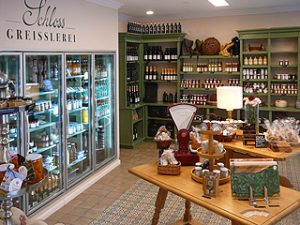
In Austria, home distilling is legal and was once widely practised. Markus Wieser’s interest in distillation dates from when as a young man he experimented with his grandfather’s still. With three outlets in Dürnstein, the Wachau distiller is difficult to oversee. Apart from whisky and gin, Wieser also makes an excellent schnapps from fermented apricots which is unusually smooth and well rounded. In addition to alcoholic products, he and his wife also offer jams, confectionery and healthcare products with the last two using the otherwise neglected kernels of Wachau apricots. See www.wieserwachau.com. In Dürnstein the Wiesers have three outlets: two at the eastern end of the town and one at the western end.
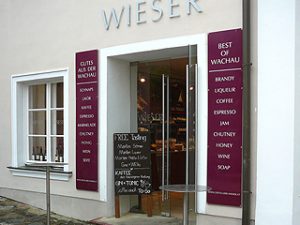
For the adventurous and able-bodied, the Vogelbergsteig offers the chance of experiencing Dürnstein’s rocky crags at close quarters. Steep paths and ledges that run along cliffs, slowly zigzag their way up from the western end of the town, bringing the intrepid walker up to the Kanzel and the Schloßberg whilst repeatedly offering spectacular views.
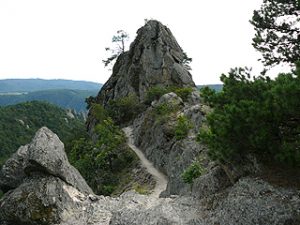
564 Metres above sea-level, the Schloßberg is surmounted by the Starhembergwarte, an outlook tower from which the surrounding countryside can be surveyed. For those who neglected to organise a picnic, from April to October, the Fesslhütte provides a modest selection of hot and cold refreshments including excellent Bauernkrapfen and Mohnzelte. See www.fesslhuette.at. For detailed information and a map, type „vogelbergsteig duernstein 14755“ into a search machine and click on the link that leads to www.bergfex.at This and other routes are described in the Wachau edition of Rother Wanderführer and can be read from the 1:25,000 walker’s map NM 33-11-17.
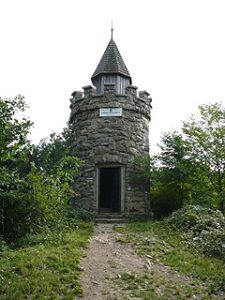
From the Starhembergwarte one can then descend via the ruins of Dürnstein Castle. Alternatively having climbed up to the ruins of Dürnstein Castle from the eastern end of the town, one can carry on to the Schloßberg and Kanzel and then make one’s way down the Vogelbergsteig. Climbing up is however a more interesting and inspiring experience and gives one a chance to reflect on what one has seen below.
